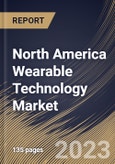The wearable technology market witnessed increased adoption due to ease of use, flexibility, and convenience. Moreover, it provides real-time data monitoring, operational efficiency, and fitness tracking, further supporting market growth. The deployment of miniature sensors into fabrics, smart watches compatibility to interact with social media, in-store merchandising, and ease of payment with wearable are some classic examples of advancement in wearable technology. The adoption of smartwatches has revolutionized watches to possess the characteristic of being multifunctional. Soon, users are expected to prefer smartwatches to their analog counterparts due to technological advancements. Growth in technical features and advancements is expected to drive the market during the forecast period.
Factors affecting the market include the entry of major players, portable and convenient usage, increased healthcare awareness, and technological advancements. These significant factors have boosted the adoption of wearable devices across various industries, such as healthcare, defense, entertainment, industries and enterprises, and others. Wearable devices, like smartwatches, activity trackers, and smart clothing, are preferred among consumers owing to their various benefits, including portable usage and the latest technological advancements.
Many Canadian companies are integrating the technology into their employee wellness initiatives. By utilizing fitness trackers and smartwatches to encourage physical workouts and a healthy lifestyle, these programs seek to enhance the well-being and health of their employees. The presence of startups and entrepreneurial ventures in Canada contributes to the innovation and diversification of this technology. Startups often bring fresh ideas and solutions to the market. The above aspects will expand the market growth across the region in the upcoming years.
The US market dominated the North America Wearable Technology Market by Country in 2022 and would continue to be a dominant market till 2030; thereby, achieving a market value of $49,560.4 million by 2030. The Canada market is experiencing a CAGR of 17.3% during (2023 - 2030). Additionally, The Mexico market would exhibit a CAGR of 16.3% during (2023 - 2030).
Based on Device, the market is segmented into Fitness, Smart Watches, Smart Glasses, Smart Clothing, and Others. Based on Product Type, the market is segmented into Wrist Wear, Eyewear, Hearables, Neckwear, Bodywear, and Others. Based on Application, the market is segmented into Fitness & Sports, Consumer Applications, Entertainment, Healthcare, Lifestyle, Defense, and Enterprise. Based on countries, the market is segmented into U.S., Mexico, Canada, and Rest of North America.
The market research report covers the analysis of key stake holders of the market. Key companies profiled in the report include Apple, Inc., Samsung Electronics Co., Ltd. (Samsung Group), Garmin Ltd., Motorola Solutions, Inc., Fitbit, Inc. (Google LLC), Nike, Inc., Adidas AG, LG Electronics, Inc. (LG Corporation), Sony Corporation and Huawei Technologies Co., Ltd. (Huawei investment & Holding Co., Ltd.)
Scope of the Study
Market Segments Covered in the Report:
By Device- Fitness
- Smart Watches
- Smart Glasses
- Smart Clothing
- Others
- Wrist Wear
- Eyewear
- Hearables
- Neckwear
- Bodywear
- Others
- Fitness & Sports
- Consumer Applications
- Entertainment
- Healthcare
- Lifestyle
- Defense
- Enterprise
- US
- Canada
- Mexico
- Rest of North America
Key Market Players
List of Companies Profiled in the Report:
- Apple, Inc.
- Samsung Electronics Co., Ltd. (Samsung Group)
- Garmin Ltd.
- Motorola Solutions, Inc.
- Fitbit, Inc. (Google LLC)
- Nike, Inc.
- Adidas AG
- LG Electronics, Inc. (LG Corporation)
- Sony Corporation
- Huawei Technologies Co., Ltd. (Huawei investment & Holding Co., Ltd.)
Unique Offerings
- Exhaustive coverage
- The highest number of Market tables and figures
- Subscription-based model available
- Guaranteed best price
- Assured post sales research support with 10% customization free
Table of Contents
Companies Mentioned
- Apple, Inc.
- Samsung Electronics Co., Ltd. (Samsung Group)
- Garmin Ltd.
- Motorola Solutions, Inc.
- Fitbit, Inc. (Google LLC)
- Nike, Inc.
- Adidas AG
- LG Electronics, Inc. (LG Corporation)
- Sony Corporation
- Huawei Technologies Co., Ltd. (Huawei investment & Holding Co., Ltd.)








